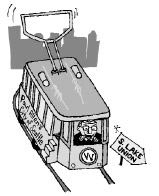ESPECIALLY GIVEN the tight budgetary times, it’s not too surprising that Seattle Mayor Greg Nickels’ sudden proposal for a $45 million wet kiss to Paul Allen—a 2.5-mile streetcar route from Westlake Center to South Lake Union—is getting panned by virtually everybody. Allen is by far the largest South Lake Union landowner, and much of his property lines the proposed streetcar project.
The co-founder of Microsoft plans to develop 10 million square feet of office and residential space in South Lake Union, and the streetcar idea, first proposed to the city by Allen’s development company, Vulcan Ventures, was specifically intended to entice would-be tenants. Even Nickels’ office is selling the idea less as effective public transportation than as proof to prospective tenants that the city is investing in the neighborhood’s future.
The staggeringly wealthy Allen would seem to be the last person to need government help to add value to his companies’ properties. Yet he has quietly (and, in the case of a football stadium, not so quietly) milked every level of government in recent years to help subsidize his investments. In South Lake Union, that includes proposals to revamp the “Mercer Mess” traffic corridor and numerous biotech-related city infrastructure improvements.
Because Allen’s riches have enabled him to buy much of both South Lake Union and SoDo—two neighborhoods likely in coming years to benefit from downtown expansion—virtually any city money spent to spur their development is bound to encounter Why-Can’t-Paul-Pay-for-It? critics.
Beyond welfare for the ber-rich, however, beyond questions as to whether a streetcar makes transportation policy sense, and beyond the consideration of what programs wouldn’t be funded instead, the Streetcar Named Paul Allen proposal raises bigger questions about how the city spends money to promote neighborhood development, and whether it’s a good idea.
Few doubt that South Lake Union will grow. The question is how. The light- industrial warehouses and final traces of Seattle’s affordable housing now in Allen’s shadow are likely to go the way of their predecessors in, for example, Belltown. To be replaced with—what? More to the point, where will Allen’s 10 million square feet of tenants come from, and how much loss of light industry and affordable housing will the city underwrite to facilitate it?
IN JANUARY, Vulcan landed a high-profile new tenant for South Lake Union. NBBJ, a venerable Seattle architectural firm now located in Pioneer Square, announced plans to design and build a 400,000-square-foot building that will occupy virtually the entire block from the corner of John Street and Pontius Avenue North, near where REI’s home store now stands. That block includes the site of the Lillian Apartments, torn down by Vulcan recently over the objections of housing activists.
That’s 400,000 square feet down, 9.6 million—or another 24 square blocks—to go. How many new tenants will come from, say, Pioneer Square? Will the city, in five or 10 years, be spending another $45 million, or more, to redevelop Pioneer Square?
Across town, bulldozers give noisy testimony each day to another example of the city’s seemingly incomprehensible neighborhood priorities. The $9 million overhaul of University Way Northeast, the troubled “Ave” shopping area just west of the University of Washington campus, is being partly paid for with federal dollars, but $5 million comes from local funds. That money is supposedly being spent to bring businesses and shoppers back to the once-thriving neighborhood.
But it’s doing exactly the opposite. The construction itself is, block by block, crippling the remaining, mostly independent businesses along the Ave. And the final product looks a lot like the old Ave, save for somewhat-wider sidewalks and some lampposts and trees to be installed later.
MEANWHILE, THE AVE’S troubles—lack of parking, competition from a refurbished University Village, public fear of street crime and ever-visible homeless youth, high business rents, and lack of business tenants that would attract out-of-neighborhood shoppers—remain completely unaddressed or (as with loss of street parking in the new alignment) are worse than ever. Putting the money into business tax credits, teen social services, or even (god forbid) a new parking garage would have made more sense. What drives these expensive decisions?
Paul Allen’s $45 million streetcar is dubious for any number of reasons. It lacks the natural (tourist) constituency that rides the waterfront streetcar and is remarkably inefficient on its own merits as public transportation. Its costs are probably badly underestimated. (As Sound Transit critic Emory Bundy points out, if the streetcar will cost only $16 million per mile, as opposed to light rail’s $200 million per mile at ground level, why isn’t the streetcar a citywide system?) And South Lake Union will likely attract new tenants, like NBBJ—streetcar or no.
Beyond its own lack of merits, this proposed naked gift raises a larger, disturbing question: In these tight budgetary times, how many other bad neighborhood development ideas are siphoning off precious city dollars?








